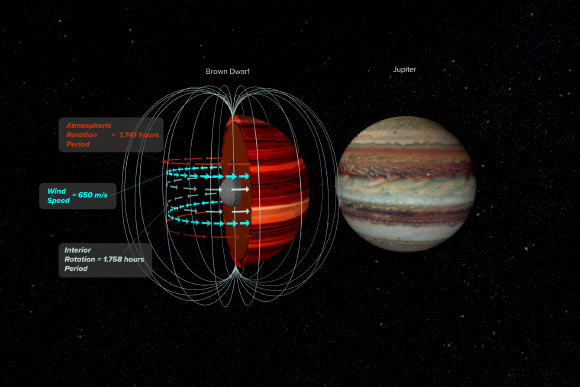Powerful Winds Blow in Atmosphere of Nearby Brown Dwarf | Astronomy – Sci-News.com
Brown dwarfs are cool, dim objects that have a size between that of a gas giant, such as Jupiter or Saturn, and that of a Sun-like star. Sometimes called failed stars, they are too small to sustain hydrogen fusion reactions at their cores and their atmospheres share many characteristics with gas giant planets. Wind speeds in atmospheres of solar system gas giants can be derived by comparing the planet’s rotational periods in the infrared (tracing the upper atmosphere) and radio (tied to the interior). Now, a team of astronomers from the U.S. and the UK has applied this method to measure the wind speeds on 2MASS J10475385+2124234, a brown dwarf located 34 light-years away from Earth, and derived an average wind speed of 660 m/sec in a west-to-east direction.

An artist’s conception of 2MASS J10475385+2124234 illustrates magnetic field and atmosphere’s top, which were observed at different wavelengths to determine wind speeds. Image credit: Bill Saxton, NRAO / AUI / NSF.
“We noted that the rotation period of Jupiter as determined by radio observations is different from the rotation period determined by observations at visible and infrared wavelengths,” said Dr. Katelyn Allers, an astronomer in the Department of Physics and Astronomy at Bucknell University.
“That difference is because the radio emission is caused by electrons interacting with the planet’s magnetic field, which is rooted deep in the planet’s interior, while the infrared emission comes from the top of the atmosphere.”
“The atmosphere is rotating more quickly than the interior of the planet, and the corresponding difference in velocities is due to atmospheric winds.”
“Because we expect the same mechanisms to be at work in the brown dwarf, we decided to measure its rotation speeds with both radio and infrared telescopes,” added Dr. Johanna Vos, a researcher in the Department of Astrophysics at the American Museum of Natural History.
Dr. Allers, Dr. Vos and their colleagues observed 2MASS J10475385+2124234 with NASA’s Spitzer Space Telescope in 2017 and 2018.
They found that its infrared brightness varied regularly, likely because of the rotation of some long-lived feature in its upper atmosphere.
They then used the Karl G. Jansky Very Large Array to measure the rotation period of the brown dwarf’s interior.
Just as with Jupiter, they found that the atmosphere of 2MASS J10475385+2124234 is rotating faster than its interior, with a calculated wind speed of about 660 m/sec. This is significantly faster than Jupiter’s wind speed, about 100 m/sec.
“This agrees with theory and simulations that predict higher wind speeds in brown dwarfs,” Dr. Allers said.
The team’s technique can be used to measure winds not only on other brown dwarfs, but also on exoplanets.
“Because the magnetic fields of giant exoplanets are weaker than those of brown dwarfs, the radio measurements will need to be done at lower frequencies than those used for 2MASS J10475385+2124234,” said Dr. Peter Williams, an astronomer in the Harvard & Smithsonian Center for Astrophysics and the American Astronomical Society.
“We’re excited that our method can now be used to help us better understand the atmospheric dynamics of brown dwarfs and extrasolar planets,” Dr. Allers added.
The results were published in the journal Science.
_____
Katelyn. N. Allers et al. 2020. A measurement of the wind speed on a brown dwarf. Science 368 (6487): 169-172; doi: 10.1126/science.aaz2856






